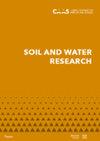不同植被覆盖下山区寒地的热特性
IF 1.7
4区 农林科学
Q4 SOIL SCIENCE
引用次数: 1
摘要
土壤的热特性调节着土壤的热平衡和水分平衡,影响着土壤的温度分布。本研究的目的是提供关于山区不同植被覆盖下孔隙空间中水分和空气的不同比例下,表土热特性变化的数据。未扰动土壤样本取自森林研究所的三个实验站——洛岑山的Gabra、日拉山的Govedartsi和马列舍夫斯卡山的Igralishte——草地、落叶林和针叶林下的表层土壤。用KD2Pro装置的SH-1传感器在实验室条件下测量了不同基质电位下的土壤热导率(λ)、热扩散率(α)和体积热容(Cv)。还使用KD2Pro装置的TR-1传感器在田间条件下的瞬态土壤湿度下测量了所研究土壤的热导率。随着土壤含水量的增加,λ的热特性增加最为明显,并与总孔隙度呈反比。总孔隙度随着土壤有机碳含量的增加而增加,随着骨架含量的减少而减少,在Govedartsi的实验站中,在不均匀Cambisols(Humic)的表层中建立了最低的λ值。由于土壤有机碳含量(SOC)和总孔隙度较低,土壤热导率随落叶林下深度的增加而增加(Gabra和Igralishte)。在草地联想之下的地下层位没有这种变化。热容随含水量的增加对SOC的依赖程度较小。在SOC小于1.5%的层位中,整个湿度范围内的热扩散率变化是SOC较高层位的1.7倍。本文章由计算机程序翻译,如有差异,请以英文原文为准。
Thermal properties of Cambisols in mountain regions under different vegetation covers
Soil thermal properties regulate the thermal and water balance and influence the soil temperature distribution. The aim of the current study is to present data on the changes in the thermal properties of Cambisols at different ratios between the water content and the air in the pore space under different vegetation covers in mountain regions. The undisturbed soil samples were taken from the surface soil layers under grassland, deciduous and coniferous forests in three experimental stations of the Forest Research Institute – Gabra in Lozen Mountain, Govedartsi in Rila Mountain and Igralishte in Maleshevska Mountain. The soil thermal conductivity (λ), the thermal diffusivity (α) and the volumetric heat capacity (Cv) were measured with the SH-1 sensor of a KD2Pro device at different matric potentials in laboratory conditions. The thermal conductivity of the investigated soils was also measured with the TR-1 sensor of a KD2Pro device at the transitory soil moisture in field conditions. An increase in the thermal properties with the soil water content was best pronounced for λ and depended inversely on the total porosity. As the total porosity increased with the soil organic carbon content and decreased with the skeleton content, the lowest value of λ was established in the surface horizons of Dystric Cambisols (Humic) in the experimental station in Govedartsi. The soil thermal conductivity increased with the depth under the deciduous forest (Gabra and Igralishte) due to the lower soil organic carbon content (SOC) and the total porosity. There were no such changes in the subsurface horizon under the grassed associations. The increase in the heat capacity with the water content depended on the SOC to less extent. In the horizons with a SOC of less than 1.5%, the changes in the thermal diffusivity over the whole range of wetness were 1.7 times higher than those with a higher SOC.
求助全文
通过发布文献求助,成功后即可免费获取论文全文。
去求助
来源期刊

Soil and Water Research
Water resources, Soil Science, Agriculture-WATER RESOURCES
CiteScore
4.60
自引率
0.00%
发文量
26
审稿时长
>12 weeks
期刊介绍:
An international peer-reviewed journal published under the auspices of the Czech Academy of Agricultural Sciences and financed by the Ministry of Agriculture of the Czech Republic. Published since 2006.
Thematic: original papers, short communications and critical reviews from all fields of science and engineering related to soil and water and their interactions in natural and man-modified landscapes, with a particular focus on agricultural land use. The fields encompassed include, but are not limited to, the basic and applied soil science, soil hydrology, irrigation and drainage of lands, hydrology, management and revitalisation of small water streams and small water reservoirs, including fishponds, soil erosion research and control, drought and flood control, wetland restoration and protection, surface and ground water protection in therms of their quantity and quality.
 求助内容:
求助内容: 应助结果提醒方式:
应助结果提醒方式:


